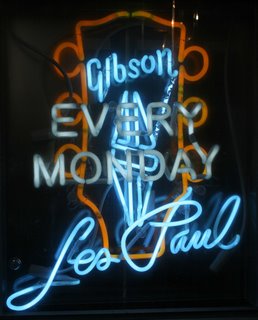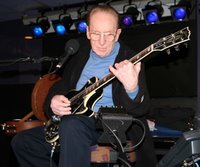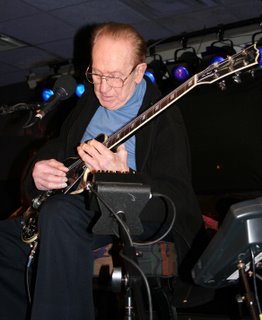LES PAUL, A NATIONAL TREASURE

To excel at one’s craft is one thing to achieve iconic status and have a monumental impact is another. It has been nearly eight decades since guitar legend Les Paul first strapped on a guitar embarking on a storied career that has seen him record and perform with artists too numerous to mention. His creation of the classic Gibson Les Paul guitar and multi-track recording were groundbreaking when first introduced making Paul one of the great innovators of the 20th century. As he approaches his 93rd birthday Paul is as busy as ever continuing to captivate audiences with his live performances, designing new guitars and inventing better hearing aids. There seems to be no stopping Les Paul.
Paul was born in 1915 in Waukesha, Wisconsin to middle class family. From an early age Paul showed an interest in music. After brief attempts to play the harmonica and then the banjo, Paul found his true calling when he was gravitated to the guitar at the age of thirteen. It didn’t take him long to begin to master the instrument. By his late teens he was performing on stage as a country artist, both solo, and with locally established bands. Even as a young man Paul showed a desire to pursue a variety of musical directions rather than be labeled as a country artist. By the 1930’s Paul was playing live jazz on a Chicago radio station while starting to record with a variety of artists. It was at this time that Paul, who was dissatisfied with the choices of electric guitars that were available, started experimenting with his own designs. As the thirties came to a close Paul moved to New York landing a spot with Fred Waring’s Pennsylvanians radio program. As he continued to tinker with his vision of building a guitar to his liking, Paul created one of the first solid body electric guitars in 1941, which, by the 1950’s lead to the Gibson Guitar Company producing the first Gibson Les Paul guitars, which have become a classic used by most every famous guitarist and a guitar by which all others are judged. Les Paul had now become an established guitar player working with Nat King Cole, the Andrews Sisters and Bing Crosby, with whom Paul developed a close friendship with until his passing many years later. With World War II now over and America on the v
 erge of entering the prosperous fifties, Paul released the song “Lover (When You’re Near Me)” on Capitol Records. What made this so special was the fact that it started out as an experiment by Paul in his garage with Paul playing eight different guitar parts, some at half speed, and mastered at normal speed. This would be the birth of multi-track recording. In the winter of 1948 Paul was nearly killed in an automobile accident shattering his right arm and elbow. At Paul’s request doctors set the arm in a crooked manner so Paul would be able to continue to play after suffering through his eighteen month recovery. The fifties would prove to be Paul’s most successful decade. The introduction of the Gibson Les Paul guitar and the Ampex Company, with the backing of Bing Crosby, began to produce and market reel to reel audio tape recording based on Paul’s original concept, becoming the foundation of the recording studio the remainder of the decade and beyond. Paul and his wife Mary Ford on vocals had a run of hit records with “How High The Moon”, “Bye, Bye Blues”, “The World is waiting For The Sunrise” and “Vaya Con Dios”. Paul continued to develop the concept of multi-track recording paying the Ampex Company, out of his own pocket, to develop the first eight-track tape recorder, which took Paul three years to finalize. Rock and Roll replaced artists like Paul in popularity and he never had a hit record using his invention. He did have the satisfaction of seeing this technology used throughout the world for the next three decades. Paul and Mary Ford divorced in 1964. With Paul’s popularity in decline, he retired in the late sixties doing the occasional studio session. With the music industry going through constant changes things remained quiet for Paul. Had it not been for the Gibson Les Paul the public might have completely forgotten about this remarkable man. Long overdue accolades were bestowed to Paul and Mary Ford beginning with the 1978 induction into the Grammy Hall of Fame. It took another ten years for Paul to be inducted into the Rock and Roll Hall of Fame by guitarist Jeff Beck who was quoted as saying, “I’ve copied more licks from Les Paul than I’d like to admit.” In recognition of Paul creating the solid body electric guitar he was inducted into the National Inventors Hall of Fame in 2005. By now Paul was doing very little performing. Following heart surgery Paul’s doctor strongly advised him that returning to the stage would be good for his overall health and well being. Paul approached Fat Tuesdays Jazz Club in New York City. “I approached the boss of the club”, recalls Paul, “I said, ‘My name is Les Paul.’ He said, ‘The Les Paul?’ “I said, boy this is the fella I’m looking for.” I said, ‘I was thinking of going to work and this looked liked the perfect little place.’ He said, “That would be an honor let’s talk about it.’ I said, “I want to be here every Monday.” He said, ‘We’re not open every Monday.’ But I said, “We want to work for nothing.” He says, “We’re open Monday’s (laughs).” Paul became a fixture at Fat Tuesday’s doing two shows every Monday night. Following a ten year run ending in 1995, Paul and his band relocated to the Iridium Jazz Club at 51st and Broadway in New York City where he continues to perform to this day. “Since I’ve been doing this I look forward to Monday’s more than any other day.” Says Paul. “ It’s the perfect night since most entertainers are off. I have found that Monday nights jam and that has made us all very happy.” In 2007 a film documentary, entitled “Chasing Sound: Les Paul at 90” was completed by John Paulson Productions. “I had been planning to do a documentary for a long time”, says Paul, “Well, I’ll do it tomorrow.(laughs) And it just never gets done.” So a film crew followed me around for about two years. The camera would be rolling while we were doing shows or signing autographs. They followed me going home coming from home, my likes, dislikes and memories. So many wonderful stories, it would be impossible to cover everything.” The world premiere, which was held in Paul’s home town of Waukesha, Wisconsin, found Paul and his trio performing a ninety-minute set prior to the screening raising over $100,000 for an exhibit on his life at the Waukesha County Historical Society. “You have no idea what it means to be back here”, Paul told the sold out crowd. I think of the wonderful days I had here and the people who taught me and who I grew up with.” This past November Paul was a guest of President George W. Bush at the White House where he was the recipient of the 2007 National Medal of Arts Award, the highest award given to artists by the United States Government. President Bush was quoted as saying, “Your accomplishments r
erge of entering the prosperous fifties, Paul released the song “Lover (When You’re Near Me)” on Capitol Records. What made this so special was the fact that it started out as an experiment by Paul in his garage with Paul playing eight different guitar parts, some at half speed, and mastered at normal speed. This would be the birth of multi-track recording. In the winter of 1948 Paul was nearly killed in an automobile accident shattering his right arm and elbow. At Paul’s request doctors set the arm in a crooked manner so Paul would be able to continue to play after suffering through his eighteen month recovery. The fifties would prove to be Paul’s most successful decade. The introduction of the Gibson Les Paul guitar and the Ampex Company, with the backing of Bing Crosby, began to produce and market reel to reel audio tape recording based on Paul’s original concept, becoming the foundation of the recording studio the remainder of the decade and beyond. Paul and his wife Mary Ford on vocals had a run of hit records with “How High The Moon”, “Bye, Bye Blues”, “The World is waiting For The Sunrise” and “Vaya Con Dios”. Paul continued to develop the concept of multi-track recording paying the Ampex Company, out of his own pocket, to develop the first eight-track tape recorder, which took Paul three years to finalize. Rock and Roll replaced artists like Paul in popularity and he never had a hit record using his invention. He did have the satisfaction of seeing this technology used throughout the world for the next three decades. Paul and Mary Ford divorced in 1964. With Paul’s popularity in decline, he retired in the late sixties doing the occasional studio session. With the music industry going through constant changes things remained quiet for Paul. Had it not been for the Gibson Les Paul the public might have completely forgotten about this remarkable man. Long overdue accolades were bestowed to Paul and Mary Ford beginning with the 1978 induction into the Grammy Hall of Fame. It took another ten years for Paul to be inducted into the Rock and Roll Hall of Fame by guitarist Jeff Beck who was quoted as saying, “I’ve copied more licks from Les Paul than I’d like to admit.” In recognition of Paul creating the solid body electric guitar he was inducted into the National Inventors Hall of Fame in 2005. By now Paul was doing very little performing. Following heart surgery Paul’s doctor strongly advised him that returning to the stage would be good for his overall health and well being. Paul approached Fat Tuesdays Jazz Club in New York City. “I approached the boss of the club”, recalls Paul, “I said, ‘My name is Les Paul.’ He said, ‘The Les Paul?’ “I said, boy this is the fella I’m looking for.” I said, ‘I was thinking of going to work and this looked liked the perfect little place.’ He said, “That would be an honor let’s talk about it.’ I said, “I want to be here every Monday.” He said, ‘We’re not open every Monday.’ But I said, “We want to work for nothing.” He says, “We’re open Monday’s (laughs).” Paul became a fixture at Fat Tuesday’s doing two shows every Monday night. Following a ten year run ending in 1995, Paul and his band relocated to the Iridium Jazz Club at 51st and Broadway in New York City where he continues to perform to this day. “Since I’ve been doing this I look forward to Monday’s more than any other day.” Says Paul. “ It’s the perfect night since most entertainers are off. I have found that Monday nights jam and that has made us all very happy.” In 2007 a film documentary, entitled “Chasing Sound: Les Paul at 90” was completed by John Paulson Productions. “I had been planning to do a documentary for a long time”, says Paul, “Well, I’ll do it tomorrow.(laughs) And it just never gets done.” So a film crew followed me around for about two years. The camera would be rolling while we were doing shows or signing autographs. They followed me going home coming from home, my likes, dislikes and memories. So many wonderful stories, it would be impossible to cover everything.” The world premiere, which was held in Paul’s home town of Waukesha, Wisconsin, found Paul and his trio performing a ninety-minute set prior to the screening raising over $100,000 for an exhibit on his life at the Waukesha County Historical Society. “You have no idea what it means to be back here”, Paul told the sold out crowd. I think of the wonderful days I had here and the people who taught me and who I grew up with.” This past November Paul was a guest of President George W. Bush at the White House where he was the recipient of the 2007 National Medal of Arts Award, the highest award given to artists by the United States Government. President Bush was quoted as saying, “Your accomplishments r emind us that freedom of thought and freedom of expression are two pillars of our democracy.
emind us that freedom of thought and freedom of expression are two pillars of our democracy.Every Monday evening Les can be found playing two shows at New York’s prestigious jazz club the Iridium, located at 51st and Broadway, to a packed room of guitar aficionados, casual fans and curiosity seekers that want to catch a glimpse of an icon who keeps going and going. On any given night Paul McCartney, Eric Clapton or Tony Bennett can be seen in the audience paying homage to a man that deserves all the accolades bestowed upon him. Paul typically plays a seventy-five minute set, which includes many classics from the day, as well as select hits he recorded with his wife Mary. One of the highlights of Paul’s set is emotional tear jerking interpretation of the classic Judy Garland song “Somewhere over the Rainbow”. “It is very rewarding to find that somehow I have accomplished something in all this craziness that is serious”, says Paul. “It’s something I don’t understand I just know that it’s happening. I’m just going about what makes me happy by performing for people and making them happy.” For further info on the Iridium and Les Paul go to http://www.iridiumjazzclub.com
Photos by Rob Nagy
Posted by
Rob Nagy
 RSS
RSS

0 Comments:
Post a Comment
<< Home